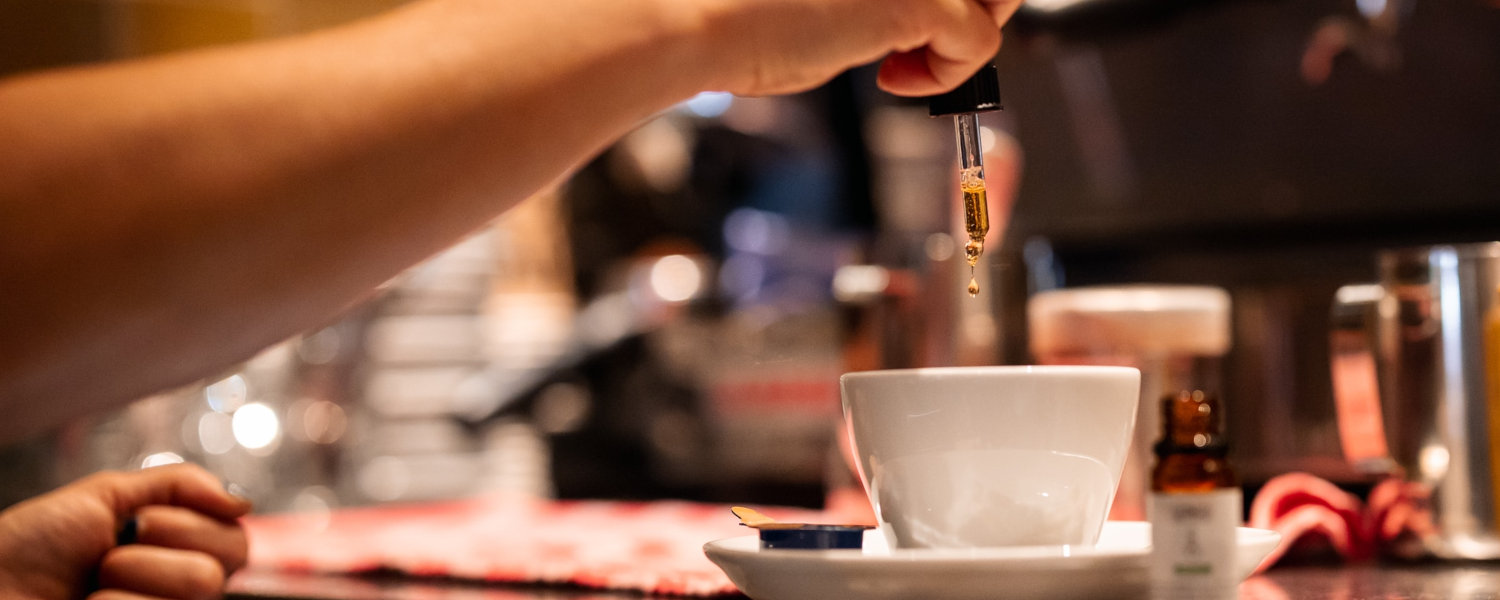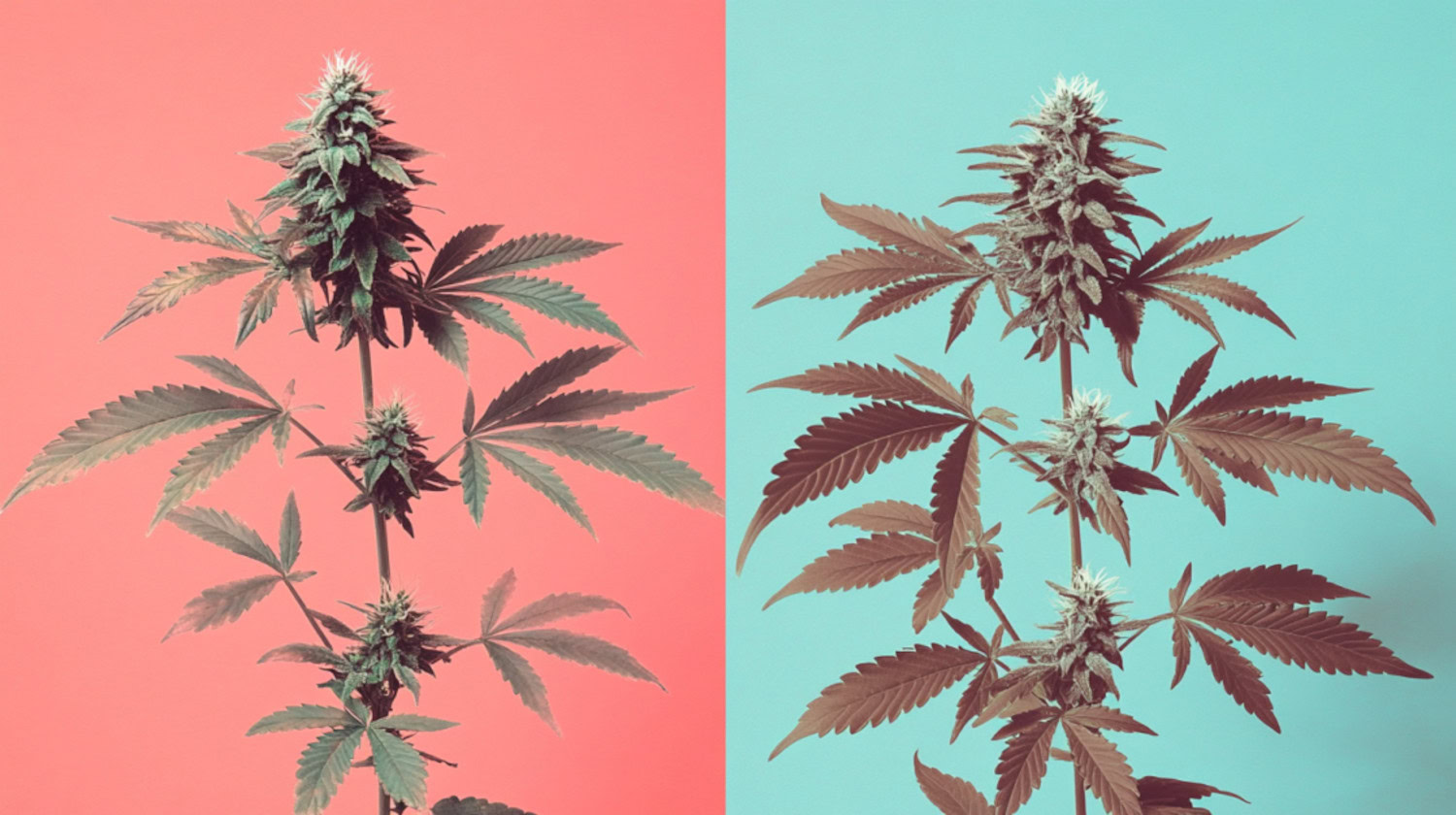In the past, many consumers turned to cannabis “to get high.” Now, more people are consuming cannabis for a growing variety of reasons, from sleeplessness to creativity. The more we learn about the plant’s potential benefits, particularly those of its 100+ cannabinoids, the more empowered we become to make decisions better suited for our own unique needs.
For a long time, THC and CBD dominated the cannabinoid conversation. But lately, more people have become aware of other important cannabinoids, like CBG, CBN, delta-8 THC, and THCA.
In this article, we take a deep dive into the cannabinoid CBDA, including how it differs from CBD and its uses and potential risks. We also discuss what CBDA is good for and how it can help certain conditions.
What is CBDA?
You might be surprised to hear that cannabidiolic acid, or CBDA, is the most abundant phytocannabinoid found in hemp plants and hemp seed oil. Like the other cannabinoids, CBDA is found in the flowers, leaves, and stems of both hemp and cannabis, although it is found in cannabis plants at a lower proportion. CBDA is the acidic precursor to CBD, so it’s similarly non-intoxicating. As the plant matures and is exposed to heat or sunlight, CBDA converts to CBD in a process called decarboxylation. This is also how THCA converts to THC.
Interestingly, cannabinoids like CBDA and THCA did not start as such. Experts have found that another cannabinoid, called CBGA (cannabigerolic acid), is the “mother” of all cannabinoids. This means that CBGA forms first and converts to CBDA, THCA, or CBCA, depending on which plant enzymes are activated. For a long time, consumers incorrectly assumed that these compounds had to be decarbed into their final forms to reap any of their benefits. However, research shows that CBDA may even have more benefits than the CBD in some cases.
CBD vs CBDA: What’s the Difference?

A cannabis or hemp plant can contain both CBDA and CBD, but CBDA is always present at much higher levels. Not only that, but CBDA could potentially be more bioavailable than CBD, depending on the method of consumption.1 For example, when you smoke cannabis, all the CBDA is converted to CBD before it can be absorbed by your body.
Another difference between the two is that CBDA does not interact with your body’s endocannabinoid system (ECS) like CBD. CBD interacts with both the CB1 and CB2 receptors in the ECS and can control how they bind with THC. CBDA, instead, impedes an enzyme called COX-2, giving the body a different, and potentially more effective, way to attack inflammation and resulting pain.2 CBD differs in that it may not be as effective for pain and inflammation unless combined with THC. CBDA also shows a greater affinity than CBD for 5-HT receptors, which produce serotonin, indicating CBDA’s potential as an antidepressant. Research into CBDA is still in its early days, however, and there is much more to uncover.
What are the Benefits of CBDA?

Because researchers have only been studying CBDA for about a decade, much of what we know is limited to results of pre-clinical studies that mostly don’t involve humans. Be that as it may, what we do know of CBDA indicates promise for its potential as a natural and effective future treatment for a variety of medical conditions.
Here are some applications that CBDA is potentially good for:
- Anti-inflammatory: CBDA has been found to selectively inhibit cyclooxygenase (COX)-2, an enzyme that is released as part of the body’s inflammatory response that causes inflammation and pain. CBDA represses this enzyme in a similar way to nonsteroidal anti-inflammatory drugs (NSAIDs) that have been developed specifically to inhibit COX-2.3 In a 2018 study, researchers found that CBDA was more effective than CBD alone to reduce inflammation and pain sensitivity in mice. These results underscore the need for further human research so clear clinical guidance can be issued.4
- Anti-nausea: CBDA appears to enhance the activation of certain serotonin receptors, called 5-HT, in a way that can suppress nausea. In a 2013 study, low doses of CBDA reduced nausea in rats and shrews, including motion and toxin-induced vomiting. In fact, CBDA appeared to work at lower doses than Marinol, an FDA-approved synthetic THC. This was an animal study, but its results suggest that CBDA could potentially be developed as an effective medicine for nausea, especially when treatment-resistant or chemotherapy-induced.5
- Anticonvulsant: The apparent ability of CBDA to interact with the body’s 5-HT receptors could also demonstrate CBDA’s potential application an anticonvulsant. The 5-HT system is involved with epilepsy, and a deficiency of 5-HT can cause seizures. In 2019, experts studied mice with a rare form of epilepsy and determined that CBDA had an effect that could reduce seizures.6 This direction of study is still early and these results have only been seen in animal models, so there is much more to learn.
- Anti-depressive: Another potential benefit of CBDA is that it interacts with 5-HT receptors in a very similar way to selective serotonin reuptake inhibitors (SSRIs), traditional antidepressant medications. So far, research has only been conducted in animal models, so further study is needed to determine if CBDA may be effective in alleviating depression symptoms.7
- Potential cancer treatment: CBDA may also be able to inhibit migration of the cells of a highly aggressive type of breast cancer, which would hinder a tumor’s ability to metastasize to other parts of the body. In a 2012 study, scientists demonstrated this effect in vitro and explored the mechanism behind this action.8 Another 2014 study supported these results.9 Although positive, these results must still be corroborated by animal and human research. And neither cannabis nor CBDA are currently accepted cancer treatments.
- Neuroprotective: CBDA may have some neuroprotective benefits, though probably not more than CBD. One 2021 study found that CBDA reduced a certain type of neurotoxicity, but not others.10 A 2020 review noted that, based on current research, CBDA may be protective for certain types of neurological conditions, like stroke and Parkinson’s disease.11 These theories are based on lab and animal studies, and there is a great need for further clinical research to illuminate CBDA’s neuroprotective potential.
- COVID-19: In a 2022 study, researchers noted that CBDA was able to prevent the infection of human cells by SARS-CoV-2, the virus that can cause COVID-19.12 This has implications for CBDA as a complementary therapy for the prevention and even treatment of COVID-19. This was a lab study and did not involve human subjects, so further testing is required to establish whether CBDA could represent an effective method of treatment.
What are the Risks and Possible Side Effects of CBDA?

The current research into CBDA indicates its benefits, but there are still many unknowns so using it does not come without risk. Just like with other cannabinoids, certain side effects are possible, and CBDA may not be ideal for some consumers.
- More study needed: There is a lack of clinical, human research into CBDA, so most of its benefits are still being studied.
- Certain unknowns: Experts don’t have any long-term safety data on the consistent use of CBDA in humans or animals. We also don’t know whether the cannabinoid interacts with other enzymes and receptors in the body.
- Problematic ingredient: CBDA is a highly unstable compound, so it may be difficult for manufacturers to use consistently in their products.
- Limited forms/methods of consumption: The effects and bioavailability of CBDA are dependent on the way in which it is consumed since it is decarboxylated when smoked.13
- Medication interaction: Because CBDA interacts with different enzymes and receptors that affect serotonin, it is possible that it could increase or decrease effects of certain medications.14
While CBDA doesn’t interact with the endocannabinoid system like CBD and THC, it may have synergistic effects when combined with other cannabinoids, suggesting that it is involved in the entourage effect.15 One 2012 study noted that when raw cannabinoids were consumed together there was a decrease in adverse effects.16 Additionally, CBDA seems to improve the absorption of CBD when the two are taken together, which could be a positive for someone who is using hemp seed oil or CBD oil.17
On the other hand, CBDA does not interact with the ECS to mediate the effects of THC like its neutral counterpart. This means it is possible that when CBDA is used with larger amounts of THC, adverse side effects could be increased, or at minimum not reduced, which could hamper a good user experience.
About Synthetic CBDA

One limitation to the study of CBDA is its instability; with time it can easily convert to CBD, even at room temperature. To get around this factor, scientists created a more stable, synthetic form of CBDA to be used for testing, called CBDA-O-methyl ester (HU-580, EPM301). Synthetic CBDA has been explored in studies into obesity, nausea, wakefulness, and anxiety. It appears to be more effective in certain cases, but this research has only been conducted on animal subjects, and long-term data does not exist.
Synthetic CBDA is created in a lab and doesn’t contain any of the compounds that are present within the cannabis or hemp plant. Because CBDA-O-methyl ester is man-made, its safety and efficacy cannot be assumed. Synthetic cannabinoids are created to replicate the natural effects of cannabinoids, but sometimes they are even more potent and cause effects that are unpredictable and severe. One 2017 study concluded that synthetic cannabis users exhibited reduced executive function compared to natural cannabis users.18 A 2014 study indicated an increase in both medical and psychiatric negative side effects in people using synthetic THC compared to people consuming natural THC.19 With a great deal of additional research required – and a history of synthetic cannabinoids presenting greater risk than their natural counterparts – synthetic CBDA should be avoided by consumers until more is known.
Where Can You Find CBDA?
CBDA is commonly found in:
- Raw cannabis
- Dried cannabis flower
- Hemp seed oil
- Full/broad spectrum cannabis oil tinctures
- Certain concentrates, like rosin and bubble hash
- Topical formulations containing full/broad spectrum cannabis
- Edibles made from hemp or whole plant cannabis
Cannabis strains that are high in CBD will naturally be rich in its acidic precursor, CBDA. These strains include:
- ACDC
- Charlotte’s Web
- Harlequin
- Hawaiian Dream
- Sour Tsunami
- Ringo’s Gift
Remember, when cannabis is smoked, the CBDA is converted to CBD, so to effectively make use of CBDA’s properties, you might want to consider making your own cannabis oil (and keep in mind that if you decarb your CBD strain before cooking you’ll convert the CBDA into CBD).
CBDA FAQs
Is CBDA legal everywhere?
No. CBDA is found in both hemp and cannabis, so when it is present in a hemp extract, it is legal in states that allow the sale and use of hemp products. When CBDA is sourced from cannabis, it can only be acquired in states with a medical or recreational cannabis program through licensed retailers.
Can you get high from CBDA?
No, you cannot. CBDA is a non-intoxicating cannabinoid, just like its counterpart CBD.20
Is CBDA more effective than CBD?
CBDA might be more effective than CBD in some cases, but this effect has only been studied in animals. CBDA has been found to inhibit an enzyme that causes inflammation.21 CBDA also exhibits a stronger affinity for serotonin-producing receptors, which could mean it is a more potent anticonvulsant and antiemetic than CBD.22
Does CBDA have an effect against COVID-19?
According to a 2022 study, CBDA may be able to protect against infection by the SARS-CoV-2 virus, which is responsible for COVID-19.23 Although this is promising, it only involves human cells in a lab, and clinical testing must be done to establish how CBDA could be a complementary therapy. It should not take the place of doctor-recommended treatment and prevention methods for COVID-19.
Can CBDA help with anxiety?
CBDA appears to have anti-anxiety and antidepressant effects. CBDA interacts with certain serotonin-producing (5-HT) receptors in a similar way24 to SSRI antidepressant medications. So far, these results have only been studied in animals and are not definite in humans.
Is CBDA the same as CBD?
No, CBDA is the acidic precursor to CBD. Hemp is rich in CBDA; the cannabinoid is also present in the cannabis plant at higher concentrations than CBD. As both plants mature or are exposed to sunlight, CBDA converts into CBD. CBDA also does not interact with the endocannabinoid system like CBD, instead, it interacts with certain enzymes and receptors in the body.
References
1 Pellesi, Lanfranco, Manuela Licata, Patrizia Verri, Daniele Vandelli, Federica Palazzoli, Filippo Marchesi, Maria Michela Cainazzo, Luigi Alberto Pini, and Simona Guerzoni. 2018. “Pharmacokinetics and Tolerability of Oral Cannabis Preparations in Patients with Medication Overuse Headache (MOH)—a Pilot Study.” European Journal of Clinical Pharmacology 74 (11): 1427–36. https://doi.org/10.1007/s00228-018-2516-3.
2 Takeda, Shuso, Koichiro Misawa, Ikuo Yamamoto, and Kazuhito Watanabe. 2008. “Cannabidiolic Acid as a Selective Cyclooxygenase-2 Inhibitory Component in Cannabis.” Drug Metabolism and Disposition: The Biological Fate of Chemicals 36 (9): 1917–21. https://doi.org/10.1124/dmd.108.020909.
3 Takeda, Shuso, Koichiro Misawa, Ikuo Yamamoto, and Kazuhito Watanabe. 2008. “Cannabidiolic Acid as a Selective Cyclooxygenase-2 Inhibitory Component in Cannabis.” Drug Metabolism and Disposition: The Biological Fate of Chemicals 36 (9): 1917–21. https://doi.org/10.1124/dmd.108.020909.
4 Rock, Erin M., Cheryl L. Limebeer, and Linda A. Parker. 2018. “Effect of Cannabidiolic Acid and ∆9-Tetrahydrocannabinol on Carrageenan-Induced Hyperalgesia and Edema in a Rodent Model of Inflammatory Pain.” Psychopharmacology 235 (11): 3259–71. https://doi.org/10.1007/s00213-018-5034-1.
5 Bolognini, D, EM Rock, NL Cluny, MG Cascio, CL Limebeer, M Duncan, CG Stott, FA Javid, LA Parker, and RG Pertwee. 2013. “Cannabidiolic Acid Prevents Vomiting InSuncus Murinusand Nausea-Induced Behaviour in Rats by Enhancing 5-HT1A receptor Activation.” British Journal of Pharmacology 168 (6): 1456–70. https://doi.org/10.1111/bph.12043.
6 Anderson, Lyndsey L., Ivan K. Low, Samuel D. Banister, Iain S. McGregor, and Jonathon C. Arnold. 2019. “Pharmacokinetics of Phytocannabinoid Acids and Anticonvulsant Effect of Cannabidiolic Acid in a Mouse Model of Dravet Syndrome.” Journal of Natural Products 82 (11): 3047–55. https://doi.org/10.1021/acs.jnatprod.9b00600.
7 Shbiro, L., D. Hen-Shoval, N. Hazut, G. Zalsman, R. Mechoulam, A. Weller, and G. Shoval. 2017. “Anti-Depressant-like Effects of Cannabidiol and Cannabidiolic Acid in Genetic Rat Models of Depression.” European Neuropsychopharmacology 27 (October): S783–84. https://doi.org/10.1016/s0924-977x(17)31426-8.
8 Takeda, Shuso, Shunsuke Okajima, Hiroko Miyoshi, Kazutaka Yoshida, Yoshiko Okamoto, Tomoko Okada, Toshiaki Amamoto, Kazuhito Watanabe, Curtis J. Omiecinski, and Hironori Aramaki. 2012. “Cannabidiolic Acid, a Major Cannabinoid in Fiber-Type Cannabis, Is an Inhibitor of MDA-MB-231 Breast Cancer Cell Migration.” Toxicology Letters 214 (3): 314–19. https://doi.org/10.1016/j.toxlet.2012.08.029.
9 Takeda, Shuso, Hiroyuki Okazaki, Eriko Ikeda, Satomi Abe, Yasushi Yoshioka, Kazuhito Watanabe, and Hironori Aramaki. 2014. “Down-Regulation of Cyclooxygenase-2 (COX-2) by Cannabidiolic Acid in Human Breast Cancer Cells.” The Journal of Toxicological Sciences 39 (5): 711–16. https://doi.org/10.2131/jts.39.711.
10 Echeverry, Carolina, Giselle Prunell, Camila Narbondo, Verónica Sánchez de Medina, Xavier Nadal, Miguel Reyes-Parada, and Cecilia Scorza. 2021. “A Comparative in Vitro Study of the Neuroprotective Effect Induced by Cannabidiol, Cannabigerol, and Their Respective Acid Forms: Relevance of the 5-HT1A Receptors.” Neurotoxicity Research 39 (2): 335–48. https://doi.org/10.1007/s12640-020-00277-y.
11 Stone, Nicole L., Alexandra J. Murphy, Timothy J. England, and Saoirse E. O’Sullivan. 2020. “A Systematic Review of Minor Phytocannabinoids with Promising Neuroprotective Potential.” British Journal of Pharmacology, September. https://doi.org/10.1111/bph.15185.
12 Breemen, Richard B. van, Ruth N. Muchiri, Timothy A. Bates, Jules B. Weinstein, Hans C. Leier, Scotland Farley, and Fikadu G. Tafesse. 2022. “Cannabinoids Block Cellular Entry of SARS-CoV-2 and the Emerging Variants.” Journal of Natural Products, January. https://doi.org/10.1021/acs.jnatprod.1c00946.
13 Anderson, Lyndsey L., Maia G. Etchart, Dilara Bahceci, Taliesin A. Golembiewski, and Jonathon C. Arnold. 2021. “Cannabis Constituents Interact at the Drug Efflux Pump BCRP to Markedly Increase Plasma Cannabidiolic Acid Concentrations.” Scientific Reports 11 (1). https://doi.org/10.1038/s41598-021-94212-6.
14 Lucas, Catherine J., Peter Galettis, and Jennifer Schneider. 2018. “The Pharmacokinetics and the Pharmacodynamics of Cannabinoids.” British Journal of Clinical Pharmacology 84 (11): 2477–82. https://doi.org/10.1111/bcp.13710.
15 Anderson, Lyndsey L., Maia G. Etchart, Dilara Bahceci, Taliesin A. Golembiewski, and Jonathon C. Arnold. 2021. “Cannabis Constituents Interact at the Drug Efflux Pump BCRP to Markedly Increase Plasma Cannabidiolic Acid Concentrations.” Scientific Reports 11 (1). https://doi.org/10.1038/s41598-021-94212-6.
16 Eichler, Martin, Luca Spinedi, Sandra Unfer-Grauwiler, Michael Bodmer, Christian Surber, Markus Luedi, and Juergen Drewe. 2012. “Heat Exposure of Cannabis Sativa Extracts Affects the Pharmacokinetic and Metabolic Profile in Healthy Male Subjects.” Planta Medica 78 (7): 686–91. https://doi.org/10.1055/s-0031-1298334.
17 Eichler, Martin, Luca Spinedi, Sandra Unfer-Grauwiler, Michael Bodmer, Christian Surber, Markus Luedi, and Juergen Drewe. 2012. “Heat Exposure of Cannabis Sativa Extracts Affects the Pharmacokinetic and Metabolic Profile in Healthy Male Subjects.” Planta Medica 78 (7): 686–91. https://doi.org/10.1055/s-0031-1298334.
18 Cohen, K, M Kapitány-Fövény, Y Mama, M Arieli, P Rosca, Z Demetrovics, and A Weinstein. 2017. “The Effects of Synthetic Cannabinoids on Executive Function.” Psychopharmacology 234 (7): 1121–34. https://doi.org/10.1007/s00213-017-4546-4.
19 Castaneto, Marisol S., David A. Gorelick, Nathalie A. Desrosiers, Rebecca L. Hartman, Sandrine Pirard, and Marilyn A. Huestis. 2014. “Synthetic Cannabinoids: Epidemiology, Pharmacodynamics, and Clinical Implications.” Drug and Alcohol Dependence 144 (November): 12–41. https://doi.org/10.1016/j.drugalcdep.2014.08.005.
20 Formato, Marialuisa, Giuseppina Crescente, Monica Scognamiglio, Antonio Fiorentino, Maria Tommasina Pecoraro, Simona Piccolella, Michelina Catauro, and Severina Pacifico. 2020. “(‒)-Cannabidiolic Acid, a Still Overlooked Bioactive Compound: An Introductory Review and Preliminary Research.” Molecules 25 (11): 2638. https://doi.org/10.3390/molecules25112638.
21 Takeda, Shuso, Koichiro Misawa, Ikuo Yamamoto, and Kazuhito Watanabe. 2008. “Cannabidiolic Acid as a Selective Cyclooxygenase-2 Inhibitory Component in Cannabis.” Drug Metabolism and Disposition: The Biological Fate of Chemicals 36 (9): 1917–21. https://doi.org/10.1124/dmd.108.020909.
22 Bolognini D, Rock E, Cluny N, et al. Cannabidiolic acid prevents vomiting inSuncus murinusand nausea-induced behaviour in rats by enhancing 5-HT1Areceptor activation. British Journal of Pharmacology. 2013;168(6):1456-1470. doi:https://doi.org/10.1111/bph.12043
23 Breemen, Richard B. van, Ruth N. Muchiri, Timothy A. Bates, Jules B. Weinstein, Hans C. Leier, Scotland Farley, and Fikadu G. Tafesse. 2022. “Cannabinoids Block Cellular Entry of SARS-CoV-2 and the Emerging Variants.” Journal of Natural Products, January. https://doi.org/10.1021/acs.jnatprod.1c00946.
24 Shbiro, L., D. Hen-Shoval, N. Hazut, G. Zalsman, R. Mechoulam, A. Weller, and G. Shoval. 2017. “Anti-Depressant-like Effects of Cannabidiol and Cannabidiolic Acid in Genetic Rat Models of Depression.” European Neuropsychopharmacology 27 (October): S783–84. https://doi.org/10.1016/s0924-977x(17)31426-8.
The information in this article and any included images or charts are for educational purposes only. This information is neither a substitute for, nor does it replace, professional legal advice or medical advice, diagnosis, or treatment. If you have any concerns or questions about laws, regulations, or your health, you should always consult with an attorney, physician or other licensed professional.




